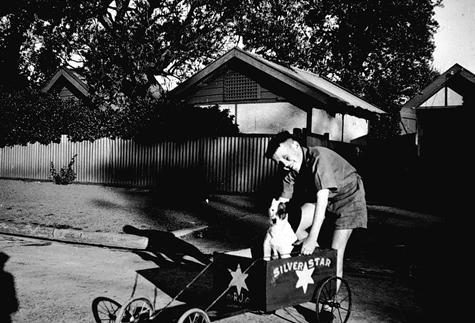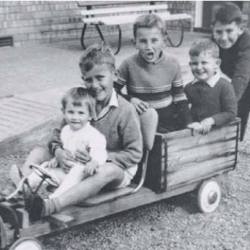When we were kids we built our own billycarts. There were no plans or instructions to be followed, just a set of four wheels, two per axle, an old apple crate, a wood paling from somebody’s fence, a bolt some nails and a bit of rope.
The most important part was the four wheels. Back then we were free to roam all over the neighbourhood on our bikes, so we’d scour the local dumps for months, waiting, until finally somebody would get rid of an old pram, for us a priceless prize. We’d somehow get what was left of the pram home, nail the apple crate onto the paling. nail the back axle underneath the crate, a shorter piece of timber for the front axle, pivoted for steering by the rider’s feet and a hand rope attached near the front wheels. No brakes or crash helmet needed (who could afford those anyway). Then we’d head for the steepest hill!

Back in the day we built our own billycarts – no plan or instructions – just 4 wheels, a box, a length of rope and a spirit of adventure
There were skinned elbows and skinned knees, all sorts of cuts and abrasions, splinters, torn clothes and holes worn in shoe leather (dragging feet along the ground was a good way to slow down). If you got to the bottom of the hill in one piece, you would have to turn around and pull the cart back to the top for the next person to take their turn. No wonder we were all so skinny then, we’d be up and down the hill twenty times in a day.
Did our parents know what we were up to? How dangerous it was? Probably, they spent much of their own childhood doing the same thing, outside playing with friends, free to roam everywhere with never a care or concern. I’m sure our parents loved us and cared about us but they gave us the freedom that parents today would never do (or could never do).

Photo from Monte Luke “When I wasn’t working on the railways, I was working on keeping the kids happy. I built this billycart at my Port Augusta home in 1968, for children (from left) AnneMarie, Paul, Christopher, John and Anthony”
Margaret Simpson, Curator of the Powerhouse Museum writes “Books on how Australian children lived in the past tell hair raising tales of them knocking together their own billycarts, scarring arms and legs, and suffering from splinters in their bottoms from wood palings pinched from someone’s fence. Brakes on billycarts were almost unknown and little care taken when the best “billycarting” hill ended intersecting with a main road. Billycart races were very popular with teams of pushers and riders. It was said to be great fun lining up together and racing down a local hill as if your life depended on it. For the grandparents of today’s children this was pretty much what many of them got up to on a regular basis. With roads full of cars and the fear of injury how many parents allow their children that freedom today?”
What are some of your memories of buiding and riding in a billycart as you were growing up?
*’Adelaide Remember When’ the book, will be published on December 1st this year. Over 200 pages of photos, stories and memories, mainly from the 1950s up to the 1980s. If you’re a baby boomer who grew up in Adelaide during those years, you’ll love this book. I’ll let you know when you are able to pre-order a copy, but the book will be available from good book shops everywhere.

We used to spent hours roaming in the hills behind the “Shanndon” looking for wheels and other stuff in dumps – great times
I am a 1950’s child, grew up in Seacombe Park, and we were always building and modifying our Billy carts (we called them Go Carts). We would have races down the streets with other home made contraptions. These provided an almost endless time of scrounging, (the local tip was a favourite place, especially if a set of wheels were found), Innovation and skill improvement, also a great sense of camaraderie was engendered with the other boys, and girls as well. Overall it helped make growing up during this time the wonder that it was.